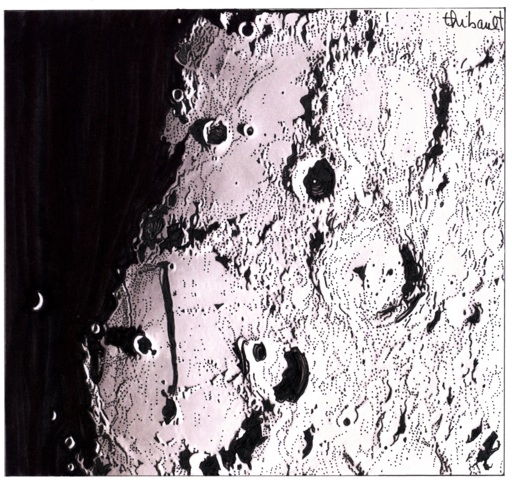
The Straight Wall
Sketch and Details by Jacques Thibault
Find enclosed one of my many drawings of the Straight Wall.
I used my D & G refractor, 127 mm achromatic, f/12, mounted on
Losmandy GM8.
18 mm and 12 mm Radian eyepieces and T-V 2X Barlow. (range : 84X
-260X, mostly 130X)
Conditions : Seing 4/5, from my backyard in Sainte-Foy, Quebec.
My working method :
1-Prior to observing, I make an outline drawing with the help of the
Hatfield Atlas. I use the outlined maps. This takes care of the
proportions and locations of the craters.
That way, I am able to concentrate on the lighting.
2-At the eyepiece, I note the shades of gray with Ansel Adam’s zone
system (0-10).
3-Back in the studio, I make a new outline on drawing cardstock (very
lightly, with a 2H graphite pencil).
4-I then use dry pastel to impart the general shade of the drawing. I
really push on the stomp to dye the paper.
5-I give a light coat of fixative to protect the pastel and to make
sure the ink will catch on the pastel surface.
6-Then I use India ink for the large black zone and different
Letraset markers to finish the drawing.
I also use an electric eraser to clear the white and to create texture.
During the drawing process I will browse in my many books on the Moon
and a wide collection of pictures taken from the Internet and other
sources.
I am not trying to make scientific observations. I just like being
alone under the stars, late in the night or early before sunrise :
it’s like walking alone by the ocean. I chose to draw because it’s by
far the best way to relive the experience. I dont make astro
photographs because I dont want to transform what is for me a
spiritual and relaxing activity into a technical marathon. I share my
drawings with my family and friends.
The very best seing to you all!
Jacques Thibault
Quebec.
I saw so many beautiful drawings on your fabulous site that I felt
that I had to send something as a token of my gratitude. Merci beaucoup.
Jacques

Outstanding sketch, Jacques! It looked too much like a photo, I had to stare for awhile to see the pen strokes. Great job! -Andy
Merci Andy!
Harold Hill is an inspiration for all Moon drawers. I TRY to use his technique… but I found that the use of very little pastel powder pushed hard in the paper pores builds a background for the intermediate values (4-6). I like these reddish grays that are reminescent of toned photographs. I then revert to Hill’s stippling technique. I actually chose to work with the pastel for the middle values because I could never achieve the beautiful regularity of Hill’s middle grays!
Jacques
Jacques,
Very impressive sketch. This is a stunningly beautiful drawing of Straight Wall. Your multi-media technique creates a unique, impressive way to generate and reveal an accurate sketch of surface features and shadows.
Le croquis très impressionnant!
Frank 🙂
Merci Andy, Merci Frank,
Harold Hill is an inspiration to all Moon drawers. The difficult part is the rendering of the intermediate grays (zones 4 to 7). He did it with his stunnily precise stippling technique. I just can’t achieve his precision… so… I had to find a way out! This is when a very little amount of pastel powder comes to the rescue. If I push very hard to get the pastel into the pores of the paper, it is easy to reach the middle grays. I use almost exclusively Holbein’s Burnt Umber ASP-21. It gives a warm shade that is reminescent of a black and white selenium toned photograph. Then, an electric eraser is a great asset to regain pure white in tight spot.
Harold Hill is to Moon drawing what Jeremy Perez is to star drawing : PURE INSPIRATION!
Jacques
Since I saw is first Moon drawing, I saw to Jacques that we would be insterested to publish a Moon Atlas with him.
I am very impressed of the details of each work he does.
I can imaging the time it takes but the tranquility it gives….. spending hours and hours, on the field, for finding small details of the Moon surface. What a nice way to evacuate modern life stress.
I am impressed about Jacques’ work!
Great!
Stefan
Stefan,
I dont want to play the humble one, but actually it does not take so long to do. Remember, I start with an outline from an ALREADY EXISTING Atlas. When I am at the refractor, I concentrate almost EXCLUSIVELY on the values, the light, the atmosphere of the scene. I trained myself very early to use Ansel Adam’s genial Zone system to evaluate values in black and white photos.
The rest is done at my drawing table with a Luxo-magnifying-glass- Lamp . The details are borrowed from my voluminous photo collection. I am trying to make a SYNTHESIS. Besides, the drawing is small yet bigger than the one you see on the screen. This reduction gives the photo like effect. It is an old trick I have learned from a graphist friend. For those interested, the original is 8 x 7.75 inches. In 3 hours, its usually done. The technique is not without drawbacks : the features on the limb are hard to draw with depth. I am working on this aspect. Later, I’ll propose another of my best drawings : Copernic or Plato.
I am also a great admirer of the work of Erika Rix. Just looking at her work made me start observing and drawing the sun. I am afraid this will cost me a few thousand dollars. I crave for a Coronado 60! I go to bed with the Coronado catalog! A bad sign!
Jacques